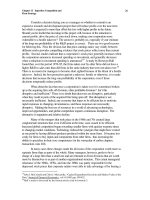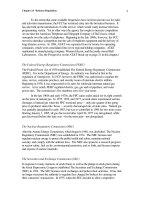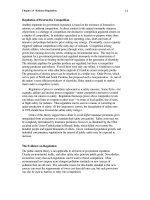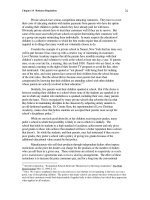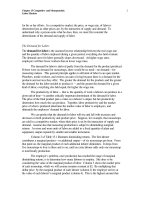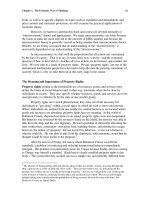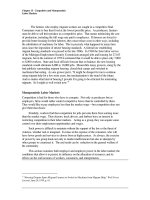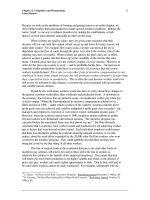Microeconomics for MBAs 55
Bạn đang xem bản rút gọn của tài liệu. Xem và tải ngay bản đầy đủ của tài liệu tại đây (68.26 KB, 10 trang )
Chapter 15 Competitive and Monopsonistic
Labor Markets
52
offers. Their firms may also be subject to takeover, given that bright investors can buy
the firm, replace the existing management team with a more competent team, and then
sell the firm at a higher price. The poor performance of one management team can
represent a profitable opportunity for their competitors in the market for firms and
management talent.
Concluding Comments
In a competitive labor market, wage rates are determined by the interaction of willing
suppliers of labor (employees) and demanders of labor (employers). Suppliers are
influenced significantly by the nonmonetary benefits of employment, as well as by the
value they place on their next-best alternative employment. Thus differences in money
wage rates may not reflect true differences in full wage rates. Demand is influenced by
the laborer’s productivity and the price of the laborer’s product.
In a competitive labor market, any attempt to change workers’ incomes through
minimum standards for wages or working conditions can benefit some workers only at
the expense of others. As the economist Milton Friedman complains, “The old saying is
that Quakers went to the New World to do good and ended up doing well. Today, well-
meaning reformers go to Washington to do good and end up doing harm.”
62
Can the
mixed results of minimum wage legislation be construed as a clear-cut improvement in
social welfare? Economic analysis cannot address that highly subjective question. The
best we can do is present the deductions drawn from theory and evidence. Unfortunately,
both are conflicting, as evident in the theoretical implications of minimum-wage hikes
under competitive and monopsonistic conditions and as evident in the differing empirical
findings.
We have also shown that while it is nice to suggest that workers be paid according
to performance, the issues of providing the “right” pay for the “right” performance are
thorny ones for managers. Regrettably, the reality of managing can be tricky, as evident
in our discussion of executive pay, or, rather, “excessive” pay. There are good economic
explanations for executives to be paid more than they are “worth.”
Review Questions
1 The government requires employers to pay time-and-a-half for labor in excess of
forty hours a week. How should managers be expected to react to that law? What
effect should such a law have on the quantity of labor demanded? Why?
2 Does union support of laws outlawing child labor square with the private interests
of union members? Should society protect some of its members from some kinds
of employment regardless of monetary considerations? Why?
62
Milton Friedman, “Migrant Workers,” Newsweek (July 27, 1970): 60
Chapter 15 Competitive and Monopsonistic
Labor Markets
53
3 How could the minimum wage rate and migrant housing standards be expected to
affect the prices of consumer goods? Explain, using supply and demand graphs.
4 Suppose government requires employers to pay a minimum wage of $10 per hour
to workers over twenty-two years of age. What effect should such a law have on
the employment opportunities and wage rates of persons under twenty-two?
5 Average real wages have increased steadily over the last 100 years. What do you
think is the main cause of the increase?
6 Suppose there were a cap put on executive pay by the government. Suppose that
“excessive wages” of executives were “excessively” taxed. What would be the
effects on wages of workers down the corporate ladder?
CHAPTER 16
Public Choice: Politics in Government
And the Workplace
I have no fear, but that the result of our experiment will be, that men may be trusted to
govern themselves without a master. Could the contrary be proved, I should conclude,
either that there is no God, or that he is a malevolent being.
Thomas Jefferson
revious chapters have discussed the effects of various government policies on the
market system in general and the firm in particular. We looked at government
efforts to control the external costs of pollution. We considered the economic
impact of price controls and consumer protection laws, for example, on the market for
final goods and services. Throughout the analysis we have focused on assessing the
economic efficiency of government policy. We said little about how government policy
is determined or why government prefers one policy to another.
In this chapter, we will shift our focus to the functioning of government itself. Using
economic principles, we will examine the process through which government decisions
are made and carried out in a two-party democratic system, and consider its
consequences. Today, when government production accounts for a substantial portion of
the nation’s goods and services, no student of economics can afford to ignore these
issues.
A study of the political process is especially important for many MBA students,
mainly because a non-trivial amount of your time will be involved with seeking to change
one governmental policy or another. Moreover, politics is also endemic to many
businesses. Our discussion of the “economics of politics” has various implications for
how businesses can be expected to operate, especially those that rely on “participatory
management” processes (which are necessarily democratic to one extent or another).
The Central Tendency of a Two-Party System
In a two-party democratic system, elected officials typically take middle-of-the road
positions. Winning candidates tend to represent the moderate views of many voters who
are neither liberals nor conservatives. For this reason there is generally little difference
between Republican and Democratic candidates. Even when the major parties’
candidates differ strongly, as Ronald Reagan and Walter Mondale did at the start of their
1984 presidential campaign, they tend to move closer together as the campaign
progresses.
P
Chapter 16 Public Choice: Politics in
Government and the Workplace
2
Figure 16.1 illustrates politicians’ incentives to move toward the center. The bell-
shaped curve shows the approximate distribution of voters along the political spectrum.
A few voters have views that place them in the wings of the distribution, but most cluster
near the center. Assuming that citizens will vote for the candidate who most closely
approximates their own political position, a politician who wants to win the election will
not choose a position in the wings of the distribution.
Suppose, for instance, that the Republican candidate chooses a position at R
1
. The
Democratic candidate can easily win the election by taking a position slightly to the left,
at D
1
. Although the Republican will take all the votes to the right of R
1
and roughly half
the votes between R
1
and D
1
, the Democrat will take all the votes to the left. Clearly the
Democrat will win an overwhelming majority.
_________________________________
FIGURE 16.1 The Political Spectrum
A political candidate who takes a position in the
wings of a voter distribution, such as D
1
or R
1
,
will win fewer votes than a candidate who moves
toward the middle of the distribution. In a two-
party election, therefore, both candidates will take
middle-of-the-road positions, such as D and R.
The smart politician, therefore, will choose a position near the middle. Then the
opposing candidate must also move to the middle, or accept certain defeat. Suppose, for
instance, that the Republican candidate chooses position R, but the Democrat remains at
D
1
. The Republican will take all the votes to the left of R and roughly half the votes
between R and D
1
. She will have more than the simple majority needed to beat her
Democratic opponent. In short, both candidates will choose political positions in the
middle of the distribution.
Politicians can misinterpret the political climate, of course. Even with polls, no
one can be certain of the distribution of votes before an election. Just as producers find
the optimum production level through trial and error, politicians may suffer several
defeats before finding the true center of public opinion. Inevitably, however, political
competition will drive them toward the middle of the distribution, where the median voter
group resides. The median voter is in the middle of the political distribution.
The recent history of presidential elections illustrates how politicians play to the
views of the median voter. After an election in which the successful candidate won by a
wide margin, the losing party as moved toward the position of the winning party. After
Barry Goldwater lost by a wide margin to Lyndon Johnson in 1964, the Republican Party
made a deliberate effort to pick a more moderate candidate. As a result, the contest
Chapter 16 Public Choice: Politics in
Government and the Workplace
3
between Richard Nixon and Hubert Humphrey in 1968 was practically a dead heat. After
George McGovern was defeated by Richard Nixon in 1972, Democrats realized they too
needed a less extreme candidate. Their choices in 1976 and 1984, Jimmy Carter and
Walter Mondale, were more moderate.
In more recent times, after Ronald Reagan soundly defeated Jimmy Carter and
Walter Mondale and George Bush beat Michael Dukakis in 1988, the Democrats began
what appeared to be a move back toward the center, picking Bill Clinton, a centrist
candidate whose policies, in many ways, have been more conservative than were George
Bush’s.
The Economics of the Voting Rule
So far we have been assuming that a winning candidate must receive more than 50
percent of the vote. Although most issues that confront civic bodies are determined by
simple-majority rule, not all collective decisions are made on that basis, nor should they
be. Some decisions are too trivial for group consideration. The cost of a bad decision is
so small that it is uneconomical to put the question up for debate. Other decisions are too
important to be decided by a simple majority. Richard Nixon was elected president with
only 43 percent of the popular vote in 1968 (when a third-party candidate, George
Wallace, took almost 14 percent), but Nixon’s impeachment would have required more
than a majority of the Senate and the House of Representatives. In murder cases, juries
are required to reach unanimous agreement. In such instances, the cost of a misguided
decision is high enough to justify the extra time and trouble required to achieve more
than a simple majority.
The voting rule that government follows helps determine the size and scope of
government activities. If only a few people need to agree on budgetary proposals, for
example, the effect can be to foster big government. Under such an arrangement, small
groups can easily pass their proposals, expanding the scope of government activity each
time they do so. However, under a voting rule that requires unanimous agreement among
voters—a unanimity rule—very few proposals will be agreed to or implemented by
government. There are very few issues on which everyone can agree, particularly when
many people are involved.
A unanimity rule can be exploited by small groups of voters. If everyone’s vote is
critically important, as it is with a unanimous voting rule, then everyone is in a strategic
bargaining position. Anyone can threaten to veto the proposed legislation unless he is
given special treatment. Such tactics increase the cost of decision-making.
Government represents the people’s collective interest, but the type of voting rule
used determines the particular interests it represents and the extent to which it represents
them.
